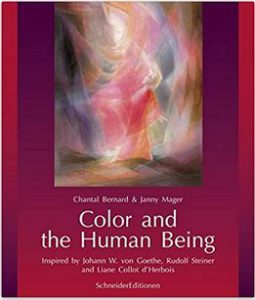Chantal Bernard and Janny Mager

Available at Schneider Editionen
Color and the Human Being
Three artists, three researchers and the mystery of color
Johann Wolfgang von Goethe, 1749 – 1832
Above the sum of all his experiences in his theory of color, Goethe proposes a revolutionary method of approaching the colored phenomenas which integrate the observer in the experience. What many scientists refuse to do in general, to consider the observer as subjective – so subject to the error – he makes a formidable tool of knowledge out of it.
Rudolf Steiner, 1861 – 1925
Finding in the Goethean method the founding elements of a new theory of knowledge Rudolf Steiner will: “… seek strictly in the world of the senses the unique object of science.” Among his many fields of investigation, he gives a privileged place to the search for the sensible-supersensible nature of color and of the human being, revealing thus a large part of the mysteries linking these two entities. Alongside their work as scientists, Johann Wolfgang von Goethe and Rudolf Steiner have also developed a significant body of artistic work. Both have painted, drawn, written poems and theatre plays.
Liane Collot d’Herbois, 1907 – 1999
As a painter, but also as a researcher, Liane Collot d’Herbois adds a new dimension to the search of these brilliant predecessors. Her intimate knowledge of the laws acting in the background of the appearance of color allows her to create a new way of painting. Her intimate knowledge of these same laws acting in the background of our constitution allows her to create a new way to heal with color. Liane Collot d’Herbois collects in a decisive way and a remarkable unity the different similarities existing between the being of color and the human being. She shows in a masterly and marvellous way how, during his whole evolution, the human being is accompanied by color. She will also extend this knowledge into the field of therapeutics.
Rudolf Steiner said about Goethe’s theory of color: These truths regarding color can only be understood in the future, perhaps not before the second half of the 20th or even the first of the 21st century.

Available at Schneider Editionen
Diagnosis and Therapy after Liane Collot d’Herbois
In order to understand why we become ill, it is important to understand why and, above all, how we stay healthy. To support us on this path, we draw on Rudolf Steiner’s knowledge of the world and the human being. We will learn in the first part of the book how the human constitution is based on a tripartite organisation – which we call threefoldness – and function according to precise laws which we will learn to recognise. The second part is devoted to the study of the fourfold nature of the human being: spiritual, animal, etheric and physical, in its relation to the elements and kingdoms of nature. We will then resume the first part of Rudolf Steiner’s lecture of 11 February 1923, somewhat different from our first study. These remarks will enable an expansion of our inderstanding of human nature and its tendencies towards pathology, in two main directions: the inwardly acting, tumour-forming forces and the outwardly acting purulent inflammatory forces. Because to take up what has just been said in a different way: When speaking of health, illness is always the expression of an imbalance, a surplus or a deficiency in the processes that otherwise keep people healthy.
Chantal Bernard and Janny Mager succeeded in thoroughly working through the demanding art therapy method created by Liane Collot d’Herbois and her anthroposophical foundation ideas. This concise research-study concerning th different types of depression will interest the specialist as well as the concerned layman, and affords deep insights into the effectiveness of this therapeutic method. “Look at the picture; is it something moving that for a moment has come to a stop? How is it moving, where did the movement come from, and where will it go?” Liane Collot d’Herbois
Mickaela Glöckler, M.D.
The artistic and therapeutic faculties of Liane Collot d’Herbois, along with her profound knowledge of the human being, have enable her to make an unprecedented contribution to art therapy through color. Her work opens immense possibilities for research, of which this publication is a wonderful example. This book brings us a new understanding of depression through this very powerful therapy that reveals and at the same time allows us to act upon the invisible forces at work in us.
Philippe Ercolano, M.D.